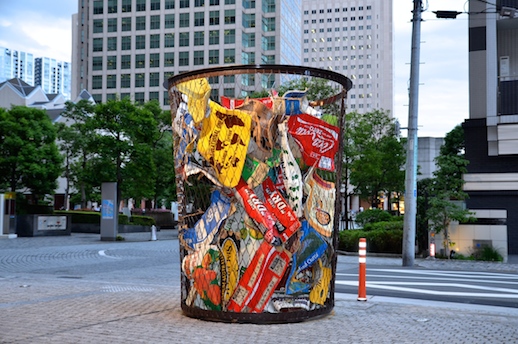Public Art Series #8: Kimiyo Mishima’s Trashcan

Consumer waste is often a source and a subject for contemporary artists. In 2000, Yuken Teruya began creating dioramas of trees within, and from, paper shopping bags in the series ‘Notice Forest’. In the late 1990s, Tomoko Takahashi became known for marshaling refuse into deceptively chaotic installations that had been carefully orchestrated to question notions of order and classification. And for over twenty years, Fumioko Aono has been salvaging materials in Miyagi to make inventive, ramshackle assemblages. Kimiyo Mishima’s Work 2012 stands on Tennōzu Isle as a recent example of this, but one that belongs to a longer legacy, as Mishima has been fabricating discarded ephemera since the early 1970s.
Making “breakable printed matter,”[1] her practice combines ceramics with printmaking. Reproducing ordinary, recyclable items – stacks of newspapers, crumpled magazines, advertising flyers, food packaging, fruit boxes, milk cartons and drinks cans – Mishima’s work is typically fired from clay before being silkscreened. She arrived at this process after using torn newspapers and magazines in collage-making, but during 1970 the artist first reprinted a page from The New York Times onto a ceramic surface. Transposing readymade veneers onto remade objects, Mishima began reproducing printed consumables.
Commissioned by Toyoko Inn Hotel, Work 2012 (2012) is part of the ‘Rebirth’ series. Admittedly, the initial impression is a little underwhelming as the sculpture stands on a cobbled hotel forecourt between shuttle buses and taxis. Situated in an area used principally for transit, Work 2012 is as tall as the coaches that swerve around it, but despite the traffic it still manages to impose its physicality. Looming and oblivious to its surroundings, it’s full of supermarket colours and cardboard textures, of worn corners and frayed edges that have become sodden in the rain.
What’s initially striking about the scene is how apparent the waste is, as discretely designed receptacles usually mask our consumption. Here the squandered remnants – a jumble of national beverages and imported commodities – are in plain sight. Japanese lagers, whiskies and empty sake cartons are among the debris, while the rest are goods that have been shipped from overseas. Sugarless softs drinks and cigarettes from America, citrus fruits from Australia, Kiwis from New Zealand, oranges and lemons from California, mentholated cigarettes and more. Apart from the fruit, this list could almost describe the contents of a hotel vending machine or minibar, just metres away in the neighbouring accommodation.
Despite the close proximity demonstrating how available these goods are, the products represented in the work haven’t been chosen in response to their specific surroundings. Mishima’s choice of items is merely a selection of readily consumed merchandise. That they coincide with what’s on offer is because she shows common, affordable items. In this sense, Work 2012 is an everyman-like reflection of consumer appetite.
Using such instantly recognisable commodities also influences how we regard, or disregard, them visually. Seeing the familiar packaging, we identify these products sooner than we explore their appearance. When you do look closer, you’ll see that the print work is crisp and that the ceramic pieces are held together with thin metal wire. It’s rendered accurately, but it doesn’t quite stand up to close scrutiny as a hyper-realistic illusion. Neither is that the point. Both its subject and its perception, Mishima’s sculpture belongs to the instantaneous. Work 2012 isn’t dazzling or picturesque. It’s unidealised; it shows what we scoff and guzzle.
Mishima’s practice is often understood in conjunction to her newspaper pieces and so is frequently interpreted as a metaphor for our insatiable appetite for information, but newspapers are absent here. Although it does share the same shape and proportions as a desktop icon of a trashcan, it’s fair to say that as it isn’t filled with discarded documents, this series differs her most well-known work.
It may sound contradictory to make a commentary on consumerism by putting something physical into the world in the first place. The dilemma must play out for the ecologically conscientious artist: whether to continue to populate the planet with more objects or to reuse existing objects in new ways. This is particularly pertinent to Mishima’s work as her practice entails farming the soil for raw materials while landfill sites clog the earth’s surface with refuse elsewhere. Work 2012 answers this dilemma by using a medium that has minimal environmental impact but material longevity to engender a discussion on ecology. In making the perishable permanent, Mishima’s buckled ceramics are husks of our age for the next.
Access: From Tennōzu Isle Station, take Exit B. At street level, turn left. Almost immediately, you’ll come to a crossroads. Turn left at the crossroads and continue walking in the same direction for a minute. You’ll see a convenience store on your right. The artwork is in the narrower road to the left of the convenience store.
[1] quote from the artist
Nick West
Nick West



